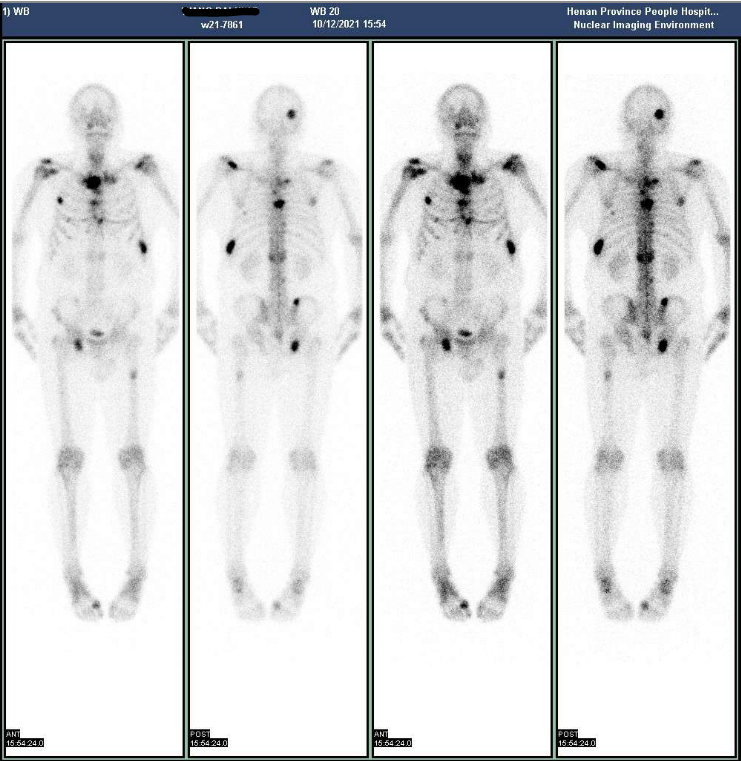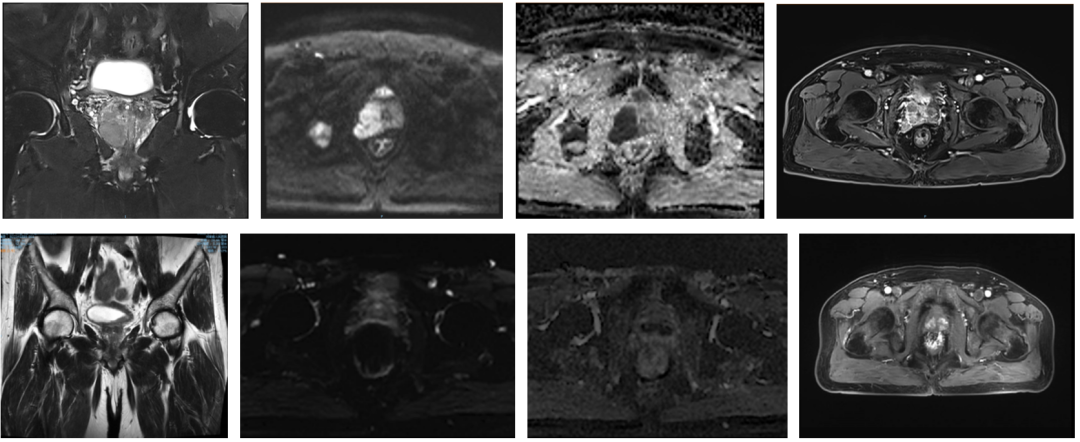PSA has a deep decline, OS long -term "Ke" period, Adt+Aparel amine combined therapy for MHSPC patients to win survival opportunities | Classic cases
Author:Cancer Channel of the Medical Time:2022.09.20
*For medical professionals for reading reference

Classic case sharing ~
Both patients are metastatic hormone sensitivity prostate cancer (MHSPC) cases. After the diagnosis, Apahamine+androgen deprivation therapy (ADT) treatment is given. , Achieve a deep decline in PSA. In subsequent continuous treatment, the PSA dropped further to <0.001ng/ml and maintained stable and the image results also improved significantly. Bring a long -term hope of survival for patients.
Review of the disease (1)
▎ Basic situation
Male patients, 66 years old;
On October 08, 2021, patients were "found to have a significant increase in PSA during the physical examination (the PSA was significantly increased (PSA was abnormally increased in June 2021, and the influence of the water disaster and epidemic in Zhengzhou was not treated in time)."
History of the current: Patients' medical examinations before April found that TPSA rose, frequent urination, urgency, pain, no bloody urine, check PSA: TPSA: 369.250ng/ml, FPSA: 73.260NG/ml, F/TPSA: 0.18 % Essence Improve ultrasound reminder: The volume of the prostate increases and echo is extremely uneven, and the prostate is mixed. After admission, the TPSA was reviewed as high as 759.220NG/ml, and the income department was income. In the case of self -incidence, the patient's weight lies about 2kg compared with the previous;
Rectal diagnosis: increased the volume of the prostate, the central ditch disappears, hard, and no specific nodules are touched, the activity is poor, there is no obvious tenderness, the anal sphincter is contracted and the blood is not stained with blood;
Previous history: a history of high blood pressure for 10 years, and the highest blood pressure to 180/140mmHg, the self -prosecution oral drug control is good;
▎ diagnosis and treatment
October 08, 2021 Patients to improve the MRI examination prompt:
The outer peripheral and central bands of the prostate can be visible to the central zone, with a range of about 6.3cmx3.1cmx4.5cm, T1WI as a signal, T2WI has a slightly lower signal, DWI has a high signal, ADC is a low signal. Strengthen the possibility of prostate cancer;
The right hip, right sideline, sweeping and lumbosacral and bilateral stocks have abnormal bone signals in recent sections of bilateral femoral bones, indicating bone metastasis;
The pelvic cavity and bilateral groin are slightly larger lymph nodes;

Figure 1 MRI inspection on October 08, 2021
October 08, 2021 Patients to perfect the chest+abdomen+pelvic CT examination prompt:
Double lung multi -hair nodules and tiny nodules, 10th ribs of bone destruction of the left side of the left and the surrounding soft tissue shadow;
The sternum handle and the fourth ribs on the right are combined with ECT examination;
The prostate is enlarged and calcified, and the enhancement is uniform, please combine MRI examination;
The right hip acetabular, sciatica, iliac bone and part of the vertebral body abnormal density shadow, bone metastasis;
Pelvic cavity and groin small lymph nodes;
On October 12, 2021, patients performed bone scan check reminder:
The whole body's bones are clear and complete, and the skull, sternum, ribs on both sides, scapulas, spine bones, pelvic bones, and long bones of limbs can be seen in many places. Checking tips: Multi -bone intake of radioactive increases in the whole body, multiple bone transfer (greater than 5).

Figure 2 October 12, 2021 Bone Scanning Examination
October 13, 2021 Patients under the guidance of full anesthesia under the guidance of the full anesthesia under the perineal prostate puncture biopsy:
Pathological return tips: prostate glands blister glandular cancer, GLEASON score: 4+5 = 9 points, WHO grading group 5;
Immunization group: CK34BE12 (-), P504s (+);

Figure 3 pathological examination
▎ Diagnosis
High -risk and high load MHSPC; clinical installment: T4N1M1B (T4: tumor invasion pelvic cavity; N1: lymph transfer; M1B: multi -bone transfer of the whole body)
疗 Treatment plan and efficacy assessment
In October 2021, patients began to use ADT+Apa 240mg QD+Sodium Ibasus sodium in Ibasus. After nearly 2 months, the patient's TPSA dropped from the & 759.22ng/ml before treatment to 3.35ng/ml, a decrease of greater than the decrease than 3.35NG/ml, which was greater than the decrease than more than 3.35NG/ml, which was greater than the decrease. 99%, realized PSA in -depth answers. In subsequent treatment, the patient's TPSA further dropped to <0.001ng/ml and maintained it stable. And testosterone levels also decreased significantly compared to before treatment, and maintained at extremely low levels. As of March 2022, patients have received more than May of the combined drug treatment, and follow -up TPSA remains <0.001ng/ml.

Figure 4 PSA follow -up results during treatment
April 09, 2022 (6 months for treatment) patient review MRI examination tips:
After the treatment of prostate cancer: The lesion is significantly smaller than the number of films 2021-10-08;
The right acetabular and sciatica, lumbosalbopy and bilateral femoral bones are abnormal, and the range is reduced compared to the front;
Bilateral groin is slightly larger lymph nodes;

Figure 5 April 09, 2022 (6 months of treatment) review MRI examination
April 11, 2022 (6 months for treatment) patients reviewing bone scanning check reminder:
Multi-bone metastasis of the whole body, compared with the number 2021-10-12, the degree of radioactive intake is significantly reduced, and changes are considered after treatment.

Figure 6 April 11, 2022 (6 months of treatment) review bone scan inspection
Adverse reaction management: During the treatment of patients, the drug tolerance is good, and there are no adverse events. Case review (2)
▎ Basic situation
Male patients, 66 years old;
On July 22, 2021, patients were admitted to the hospital for examination due to "discovery TPSA during the physical examination" and inspection;
Current medical history: 4 months ago, patients were found during physical examinations of patients. TPSA> 100NG/ML was found. There was no difficulty in urine, frequent urination, urgency, naked eye hematuria, and no special treatment. Review at the local hospital 1 week ago, TPSA was still> 100ng/ml. Improve the prostate MRI: The prostate abnormal signal, the prostate cancer is suspicious. The abnormal signal of the waist 4 and 5 vertebral bodies, consider bone metastases, pelvic enlarged lymph nodes and enlarged, consider the possibility of metastasis. In order to come to our hospital for further diagnosis and treatment, the outpatient clinic uses the "prostate cancer with bone metastasis to be arranged";
Rectal diagnosis: increased the volume of the prostate, the central ditch disappears, hard, and no specific nodules are touched, the activity is poor, there is no obvious tenderness, the anal sphincter is contracted and the blood is not stained with blood;
Past history: no special medical history;
Admission laboratory inspection: TPSA: 918.2.ng/ml, testosterone: 5.6ng/ml;
▎ diagnosis and treatment
A reminder of the patient scanning examination on July 22, 2021:
The left side of the first rib, the 7th rib, the 4th, and 12th thoracic spine intake of the radioactivity increase, except the bone metastasis, it is recommended to combine other inspections;
A radioactive increase in the right knee joint, consider arthritis lesions;
The right kidney and the right ureter are abnormal, considering the stagnant water;
Figure 7 Bone Scanning Examination on July 22, 2021

In July 2021, patients perfected the SPECT/CT examination prompt:
PSMA appearance positive;
The prostate morphology is irregularly accompanied by soft tissue mass, and the PSMA is increased. Considering prostate cancer, please combine the clinic;
The pelvic cavity is more swollen and large lymph nodes.
The bones are seen into multiple bone destruction shadows in many places, and the psma intake increases to varying degrees to consider bone metastasis;
Right renal pelvis-ureteral expansion effusion;
Figure 8 SPECT/CT inspection in July 2021


On July 27, 2021, patients under the inferiority of the game under the ultrasound guidance of the bureau were under perineal prostate puncture biopsy:
Pathological return tips: prostate glands blister glandular cancer, GLEASON score: 4+5 = 9 points, WHO grading group 5;
Immunization group: CK34BE12 (-), P504s (+);
Figure 9 pathological examination

▎ Diagnosis
High -risk and high load MHSPC; Clinical installment: T3N1M1B
疗 Treatment plan and efficacy assessment
In July 2021, patients began to use ADT+Apa 240mg QD+Pipidic acid combined treatment; after nearly 2 months of treatment, the patient's TPSA dropped from & 918.2ng/ml before treatment to 12.57ng/ml, and then subsequently After the treatment in February, it quickly dropped to 0.1ng/ml, a decrease of more than 99%, and realized PSA in -depth response. In subsequent treatment, the patient's TPSA further dropped to <0.001ng/ml and maintained it stable. And testosterone levels also decreased significantly compared to before treatment, and maintained at extremely low levels. As of February 2022, patients have received more than July for joint drug treatment, and follow -up TPSA remains <0.001ng/ml.
Figure 10 TPSA, testosterone follow -up results during treatment

Adverse reaction management: During the treatment of patients, the drug tolerance is good, and there are no adverse events.
Analysis
While improving the 5 -year survival rate of cancer patients, the quality of survival is also worthy of attention; not only must they live longer, but also live better; from the level of scientific evidence, research has been confirmed that the treatment of diseases can be in the early stage of disease treatment. The deep decline of PSA, which can be used as a "strong prediction factor" for long -term survival benefits. The lower the valley value, the longer OS more research supports PSA 0.2ng/ml as the critical value of distinguishing the prognosis. [12-15], the above two cases of high tumor load and high-risk patients choose the ADT+Aparel amine plan for treatment to be 0.2ng/ml after treatment. Treatment confidence and reduce psychological pressure.
Expert profile provided by the case
Professor Wang Xiangyang
Deputy Chief Physician of the Department of Urology, Henan Provincial People's Hospital
Deputy Chairman of the Youth Committee of the Henan Medical Association's Urology Branch
Deputy Chairman of Henan Medical Information Society's Urology Branch

Deputy Chairman of Henan Provincial Senior Medical Association Urology Special Committee
Member of the Henan Medical Association Urology Department of Urology
Youth Member of the Henan Medical Association Urology Medicine Branch
Member of Henan Province Sino -Western Integrated Urology Branch
Expert Comment 1
In recent years, multiple authoritative outlines/white papers have put forward the requirements for the survival rate and quality of survival of tumor patients, and put forward the requirements of "providing the people with all life cycle health management" for cancer prevention and the survival rate of cancer patients. In 2030, the 5 -year survival rate of overall cancer increased by 15%. The above two cases based on the current guidelines, drugs and nature, and patient's condition. Multi -active treatment plans are applied to the 5 -year survival rate of clinical prostate cancer in the clinic. The treatment of 28 patients with prostate cancer in our hospital also chose a more active treatment plan because of the choice, which brought confidence to patients' confrontation with prostate cancer. The details of our hospital's cases are as follows:
Henan Cancer Hospital Experience:
Figure 11 Base Line of Henan Cancer Hospital
The above patients are all treated with standard ADT+Apa Tasamine. During the follow -up process, the average time of PSA90 and bone pain relief was about 1 month. Due to the rapid depth of patients and the rapid relief of symptoms, the psychological pressure of the tumor was reduced. Maintain the treatment of existing schemes and look forward to future life.

Figure 12 Results of the real world follow -up of Henan Cancer Hospital+TITAN Research Results [11]
Comment expert Introduction Profile

Professor He Chaohong
Doctoral Master Student Tutor
Director of the Department of Urology, Henan Cancer Hospital
Member of the Professional Committee of the China Anti -Cancer Association Urinary Men's Reproductive Cancer
Vice Chairman
The diagnosis and treatment of adrenal tumors, renal tumors, ureteral tumors, bladder tumors, prostate tumors, and gaggame tumors have profound accomplishments, and they are good at minimally invasive urology technology. Prested 1 Henan Provincial Science and Technology Customs Research Program, 3 Henan Medical Science and Technology Customs Research Program, 1 Middle -aged and Middle -aged Teachers Teachers, 1 National Natural Science Foundation Project, and 1 National "973" plan project sub -project Won one second prize of Henan Province Science and Technology Progress, and obtain one department -level scientific and technological achievement.
Expert Comment 2
In recent years, with the intensification of Chinese population aging, the incidence and death of prostate cancer in my country have shown a significant upward trend, and the burden on disease has increased. Prostate cancer has gradually entered the public vision by "rare diseases" in traditional cognition. According to Globocan 2020 Chinese data, the number of occurrence of 2020 prostate cancer is ranked sixth and seventh in male cancer [10], and the total incidence of prostate cancer in my country has risen rapidly year by year. About 30%of the distant transfer is much higher than Western countries [8,9]. The statistics of the SEER database of 2000 to 2017 showed that the 3-year survival rate of patients with prostate cancer who was first diagnosed with M1 was less than 50%, and the 5-year survival rate was only 30.6%, which was far lower than the limitations and local progressive prostate cancer [5]. The two patients with MHSPC mentioned above were in conventional physical examinations. They found that the PSA was significantly higher and further examined the diagnosis. They had no typical symptoms before the onset. This is also consistent with the characteristics of prostate cancer, and symptoms are not typical. Although the preliminary diagnosis of the above patients is already advanced, and active treatment can still obtain longer survival benefits.
How to choose among many active treatment plans? Judging from the benefits of the actual world study of patients with Apausamine, Aibi Dragon, and Enzaluramine in patients with MHSPC patients, compared to the benefits of actual world research, compared to Aipilong and Enzaramine, patients with mHSPC patients have reached PSA90 and PSA dropped to <0.2ng/ml ratio, and faster [4].
Figure 13 A retrospective vertical queue research-real world data retrospective
In the practice of clinical research and real -world diagnosis and treatment, the Apatamine+ADT scheme can all achieve PSA deep declines and lasting long -term maintenance to bring greater survival benefits to patients. The in-depth decline of PSA in the above two cases (<0.001ng/ml) allows patients to quickly perceive the effectiveness of the treatment plan, improve the treatment confidence, and reduce psychological pressure [16-18].

Comment on the second expert profile of the expert
Deputy Chief Physician of the Department of Urology, Henan Provincial People's Hospital
Professor Hu Zhiquan
Deputy Director of Tongji Hospital Department of Tongji Medical College of Huazhong University of Science and Technology
PhD, professor, chief physician, doctoral supervisor
Member of the oncology group of the Urology Branch of the Chinese Medical Association
Standing Committee Member of the China Anti -Cancer Association Urinary Men's Reproductive Cancer Professional Committee and Deputy Leader of the Minimally Invasive Team

Standing Committee of the Prostate Cancer Committee of the China Clinical Oncology Society
Standing Committee Member of the Urology Professional Committee of the Pharmaceutical and Health Exchange Association Cross -Strait
Chairman of the Hubei Provincial Anti -Cancer Association Urinary Men's Reproductive Cancer Branch
Deputy Leader of Hubei Medical Association's Urology Branch of the Department of Urology Branch
Director of the Tumor Research Office of Hubei Province Institute of Urology
Member of the Hubei Medical Association Urology Branch
Member of the Hubei Medical Association's Urology Branch
Deputy Chairman of the Urology Branch of Wuhan Traditional Chinese and Western Medicine Society
SIU
"Research on Tumor Prevention", "Modern Urology Tumor Magazine", "Clinical Urology Edit", "Chinese Physician Magazine (Electronic Edition)"
references:
[1].Chi KN, Agarwal N, Bjartell A, Apalutamide for Metastatic, Castration-Sensitive Prostate Cancer. N Engl J Med.2019 Jul 4;381(1):13-24[2].Cao W,Chen HD, Yu yw, et al. Changing Profiles of Cancer Burden Worldwide and in China: A Secondary Analysis of the Global Cancer Statistics 2020 [J]. Chin Med J (English) .00000000001474.
[3]. Ma Chunguang, Ye Dingwei, Li Changling, etc. .issn:0529-5815.2008.12.012. Ma CG,Ye DW,Li CL,et al. Epidemiology of prostate cancer from three centers and analysis of the first-line hormonal therapy for the advanced disease[J]. Chinese Journal of Surgery, 2008, 46 (12): 921-925.doi: 10.3321/j. ISSN: 0529-5815.2008.12.012.
[4] .pilon d, et at. Presented at aMCP Nexus; October 18-21, 2021
[5].https://seer.cancer.gov/explorer/application.html?site=66data_type=1graph_type=2compareBy=racechk_race_1=1rate_type=1hdn_sex=2age_range=1stage=106advopt_precision=1advopt_show_ci=onadvopt_display=2
[6] .chen w et al. CA CANCER J clin. CA CANCER J CLIN. 2016 Mar-APR; 66 (2): 115-32. 2. 2.
[7]. Gu Xiuying, et al., China Prevention Medicine Magazine. 2018, 52 (6): 586-592
[8] .r. Chen, S. Rhh Sun, et al. PRostate Cancer in Asia: a color protection report. Asian Journal of UROLOGY. (2014) 1,15-29
[9] Dingwei Ye, 2019 2019 PROSTATATE CANCER Asian Adapted Guideline: SHANGHAI CONSENSUS Meeting Report
[10] .globocan 2020
[11] .chi kn, et al. Presented at an asco 2020 virtual scientific propram
[12] .lin TT, et al. J Cancer 2019 SEP 7; 10 (22): 5608-5613.
[13] .huang SP, et al. PRostate 2011 AUG 1; 71 (11): 1189-1197.
[14] .huang SP, et al. AGing Male 2010 mar; 13 (1): 10-17.
[15] .tomioka a, et al. BMC UROL 2014 APR 29; 14: 33.
[16] .lim dm, et al. PROSTATE 2018; 10.1002/Pros.23666;
[17] .rinnningås u, et al. BMC UROLOGY 2019; 19: 66; [18]. Gorawara-Bhat R, et al. Journal of GerIiatric Oncology 2017; 8: 368-373.
*This article is only used to provide scientific information to medical people, and does not represent the viewpoint of this platform


- END -
Jiuquan: Empowering the mother's health and happiness with heart
Empower the mother's health and happiness with heart——The Municipal Women's Federation to carry out the Healthy China · Mother Action three -in -three -to -three -free theme activityIn order to i...
Heilongjiang's latest epidemic notice

At 0-24 on September 16th, there were 3 cases of new native infections in Heilongj...